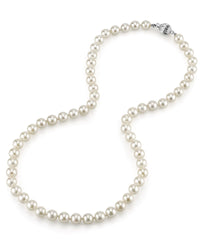
Japanese Akoya White Pearl Necklace, 6.5-7.0mm - AAA Quality
$1,540.00 Sale: $1,309.00


These intensely colored Metallic Freshwater pearls have been matched to perfection! We'd love to have a pair for some earrings.

Every day we receive questions from customers all over the world about pearls. We decided to post our answers here for every one to read!

Take a look at the pearls Kevin is holding in his hand above. Notice the detailed reflections in the pearls' surfaces and the brightness of the light sources reflected on the pearls? THAT'S luster!
Now that you know what luster looks like, let's talk about what all this actually means, and how luster as an attribute of pearls actually gets evaluated and graded.

Luster is arguably THE MOST important aspect of a pearl’s value, beating out surface quality, symmetry of shape, size and color by a mile. If a pearl doesn't have nice luster, it just isn't going to be worth much. Luster is one of the famous “Value Factors” that jewelers, pearl specialists and appraisers use to grade pearls.
Pearl luster has three components:

Akoya pearls are known around the world as having the highest quality luster of all pearl types. The luster is so sharp, shiny and reflective that Akoya pearls are often described as having “Mirror-sharp” or “Ball-bearing” luster.
Akoya pearl luster can be graded as Excellent, Very High to Excellent, Very High, High, Medium and Poor.
“AAA Quality” Akoya pearls MUST have either "Excellent" or "Very High to Excellent" luster in order to qualify for the grade.
"AA+ Quality” Akoya pearls should have luster that grades "Very High" or "High to Very High" to qualify.

Hanadama Akoya pearls will have the very highest graded luster of all Akoya pearls, which is “Excellent” … and then some! Hanadama pearls truly are the "Ferrari of the Pearl World" ...
For Hanadama Akoya, you can find the luster grade on the certification listed as “Teri-Value” which must be graded as “Very Strong”.

Freshwater pearls have long been thought to have the lowest luster of all pearl types, but that certainly doesn’t hold true today. That said, the luster of Freshwater pearls is generally softer and not as “crisp” as that of the Japanese Akoya. This is due to their solid crystal nacre make-up, which makes the pearls very durable. However, this composition slows down light beams reflecting back at the viewer making for a softer, more satin-like sheen overall.
Like Akoya pearls, Freshwater pearl luster can be graded as Excellent, Very High to Excellent, Very High, High, Medium and Poor.
“AAA Quality” Freshwater pearls must meet either "Very High to Excellent" or "Very High" luster in order to qualify for the grade.
"AA+ Quality” Freshwater pearls should have luster that grades "Very High" or "High" to qualify.

Tahitian pearls are cultured pearls spend quite a bit of time in the water acquiring their thick layers of nacre … typically 2 years is the minimum. So it comes as no surprise that Tahitian pearl luster is described as “satiny”. But that doesn’t mean that Tahitian pearl luster can’t be sharp, highly reflective and totally beautiful.
Like other pearl types, Tahitian pearl luster is graded as Excellent, Very High to Excellent, Very High, High, Medium and Poor.
“AAA Quality”Tahitian pearls can have either “Excellent” or “Very High to Excellent” luster.
“AA+ Quality” Tahitian pearls should have luster that grades “Very High to Excellent” or “High to Very High” to qualify.

Like Tahitian pearls, White and Golden South Sea pearls are pearls that spend between 2-3 years in the water acquiring extremely thick nacre layers. These stunning pearls have luster that is also often described as “satiny” looking, but these stunners are not limited to soft luster levels at all. Quite the contrary, fine quality White and Golden South Sea pearls can have a deep, lustrous glow and silky shine that is unlike any other pearl type out there today.
South Sea pearl luster is graded as Excellent, Very High to Excellent, Very High, High, Medium and Poor.
“AAA Quality” South Sea pearls can have either “Excellent” or “Very High to Excellent” luster.
“AA+ Quality” South Sea pearls should have luster that grades “Very High to Excellent” or “High to Very High” to qualify.